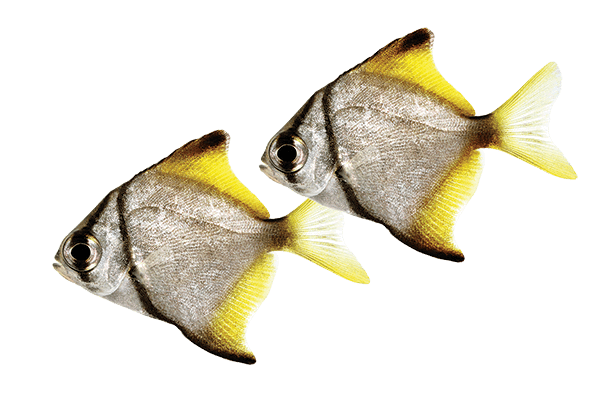Mono Argentus fish or Mono fish, Moonfish and even Fingerfish as they are often called, come from oceans and waters of Australia, Eastern Africa and throughout Southeast Asia.
But are they Freshwater, Brackish or even Saltwater fish? It can be a little confusing, so let us explain in more detail. The Mono Argentus fish can be found in all three aquarium water conditions.
Mono Argentus fish are found in a variety of water conditions as they grow older. Adult Mono fish prefer to inhabit the coastal saltwater and the younger juveniles fish will stay in freshwater until they start to age when they will then start to move towards saltwater.
If you’re considering these fish for a home aquarium what type of aquarium should you house them in? Freshwater, Brackish or Saltwater?
Let us answer this question then we can provide you with some more information on this wonderful aquarium fish.
Table of Contents
Are Mono Argentus Fish Freshwater Or Brackish?
Let us clear the confusion up about these fish and the type of water they can live in when young. Mono fish can live in freshwater when young but as they grow older they will need to be acclimatized to more brackish waters and eventually when they mature they should be kept in saltwater aquariums.
This process needs to be done slowly over a period of 1-7 years from juvenile to adult.
Due to their need to live in different salinity water aquariums, Mono Argentus are only recommended for experienced aquarists who can give them the environment they will need throughout their lifespan.
Time Span
- Juvenile Fish 1-3 Years: Freshwater
- Adult fish 3-5 years: Brackish water
- Mature fish 5-7 Years: Saltwater
Species Profile
| Scientific Name | Monodactylus argenteus |
|---|---|
| Common Names | Moon Fish, Mono fish, Fingerfish |
| Family | Monodactylidae |
| Care Level | Moderate |
| Temperament | Semi Aggressive |
| Color | Silver, Brown, Whte |
| Diet | Omnivore |
| Water Conditions | 75-83° F, KH 8-12, pH 7.2-8.5 |
| Max Size | 9-10" |
| Tank Size | 120-140 Gallons Minimum |
| Tank Level | Mid water to Surface |
| Cost | $20-60 |
Origins & Habitats
Monodactylus argenteus (Mono Argentus), which is the scientific name for Mono Fish, was first documented by Linnaeus in 1758.
They are found along the coasts of Australia, Southeast Asia, and Eastern Africa. Sold throughout the aquarium world mainly as Brackish water fish, they are also known by many other names such as: Silver moonfish, Moonfish, Silver Batfish, Diamond Moonfish, Diamondfish, Fingerfish, Kitefish, Moony, Moonyfish, and Malayan Angel, as well as Singapore Angelfish,
Mono Fish are often found in large schools of fish in the shallow portions of estuaries, inshore reefs, and freshwater tidal pools. They can school in numbers upwards of 500+ fish.
More mature and larger fish inhabit the coastal saltwater areas and the smaller juveniles fish stick to freshwater / Brackish environments. These fish are not on the endangered species list and are readily available in most aquarium stores.
Due to their very specific water condition needs, they are not sold in huge numbers and good reputable stores will advise beginners to stay away from them.
Aquarium Water Conditions
The Mono Argentus are capable of growing to 10″ in length in the wild but typically they reach an average of around 7-8″ maximum in a home aquarium.
Water conditions should be 75-82° F, KH 8-12, pH 7.2-8.4. As mentioned above start them off as juveniles in freshwater and slowly introduce them to brackish water conditions. Eventually into saltwater conditions. Brackish fish do best in water with a salinity of 1.015, or 1/4 cup marine salt per gallon, and a pH of 7.5 to 8.4.
Lighting should be kept low to moderate and the aquarium furnished with plants, rocks, and driftwood.
The minimum size aquarium should be 50-75 Gallons due to their ability to reach 7-10″ and be kept in small schools of around 5-8 fish.
TECH TALK: Brackish water contains between 0.5 and 30 grams of salt per litre which is often expressed as 0.5 to 30 PPM (Parts Per Million), which is a specific gravity of between 1.0004 and 1.0226.
Diet & Feeding
Mono Argentus fish are omnivores, which means they will eat a variety of meaty foods as well as plant matter.
In the wild, a big part of their diet consists of insects and plant matter. In the home aquarium, they have a ferocious appetite and will eat just about anything. Ensure they have a balanced diet with a mixture of meaty foods, live foods like brine shrimp and bloodworms and some plant-based pellets or wafers.
They will even accept dried flake food but this should not be the only type of food you feed them. I have seen far too many mono fish looking emaciated in stores as they are not given the correct balanced diet.
Once this fish takes a dislike to their diet they will often go into shock and stop eating altogether. I have also witnessed them behaving erratically when starved or given a poor diet.
As responsible fish keepers, it is our duty to provide all our tropical fish with the best possible aquarium conditions and diet.
We like Omega One Veggie rounds which are available from Amazon. Most fish will eat them and my Mono Fish loved them!
Here is a feeding guideline that we use
| Food | How Often | How Much |
|---|---|---|
| Flake Food | 3 Times a day | Enough to consume in 90 Seconds |
| Pellets | 3 Times a week | 1-2 Mini Pellets Per Fish |
| Bloodworms - live | 2 Times a week | 1/4 Teaspoon of worms per fish |
| Bloodworm - Freeze Dried | 2 Times a week | Small Pinch |
| Algae Wafers / tablets | 2 Times a week | 1 Tablet or wafer per 10 fish |
| Brine Shrimp - Live | Once a week | 1-2 Brine shrimp per fish |
| Other supplement foods or Vegatables | 2 Times per week | Enough to consume in 90 Seconds |
Colour & Appearance
With a disc-shaped body, the mono fish simply looks incredible in a small school. Silver in color highlighted with yellow on the dorsal, anal and tail fins along with a vertical black stripe on the front and one running through the eye and gill.
Younger fish also have a vivid yellow dorsal fin. As they mature, the yellow parts of the body fade very slightly but the silver is enhanced and shines brightly under the aquarium lights.
Size: Wild 10″ and in an aquarium 6-8″ max
Lifespan: 6-8 years maximum
Aquarium Care & Tankmates
These fish are fast swimming, active and slightly boisterous fish which can cause issues in a mixed community aquarium. Kept singularly they have a tendency to nip fins and be a bit of a bully. However, in small or large schools they calm down a little. Still sometimes nipping the odd fin but in general, much calmer.
Like many fish or animal species if they feel unsettled or vulnerable they strikeout. But in a larger group, they become more placid and peaceful. However, I wouldn’t trust them totally with smaller fish and more peaceful species.
Best Tankmates for Mono Fish / Mono Argentus
Many people either keep them when they are younger with cichlids or Spotted Scats, Archerfish and fish of a similar nature.
Saying that these fish can be very timid and easily scared. Often running scared and hitting objects within the aquarium such as rocks and wood in freshwater or brackish aquariums and corals in saltwater aquariums.
They should be housed with fish of similar size and temperament.
Sexing & Breeding
There have been no reported cases of people in a home aquarium breeding these fish. There have been reported cases of breeding in larger public aquariums and fish farms.
But for the average home aquarium, the chances of breeding these fish are slim to none.
Sexing these fish is very difficult, if not impossible, from a visual point of view. The best chances of finding a breeding partner would be to house a large school of mono fish and allow them to naturally branch off into a breeding pair.
After that, there is little information about breeding, spawning or caring for their young.
You’re on your own! Let us know if you have any information or experience in sexing or breeding the Mono Argentus.
Care Level
For a number of reasons, these fish are classed a moderate to difficult to keep. Once settled into a suitable aquarium they are perfectly easy to keep. However, there are several reasons why they are classed as difficult.
We have listed a few below:
- Size, reaching a possible 8-10″
- Schooling fish. They need to be in schools of 4-6 fish minimum to feel at ease.
- Water conditions constantly changing as they mature and grow older.
- Fin nippers
- Easily spooked and scared, often resulting in their death
- Price. Due to the fact you will need 4-6 fish, the cost can mount up. At roughly $15-20 for a juvenile that’s over $100 for a small school. Adult fish can fetch upwards of $100 each
F.A.Q
- Do mono fish live in saltwater or marine aquariums? Yes, when they are older or adults
- Can mono argentus live in brackish water all their lives? Whilst it is true they can live in brackish waters from the age of 2-5 they should then be slowly acclimatized into saltwater as they grow older
- What do mono fish eat? Live foods, dried foods, frozen food and plant matter like algae pellets
- How much do mono fish cost? $15-20 for juvenile fish and upwards of $100 for adults
- What size aquarium do mono fish need? 50-75 gallons minimum and for a larger school of fish 100-150 gallons
- Can mono fish be kept with angelfish? No, they are fin nippers and will bully your freshwater angelfish.
Conclusion: Monodactylus Argenteus Buyers Guide
If you’re considering purchasing mono fish then think about the longterm care they will need. Firstly, you have the ever-changing water conditions and secondly their fast, active and often boisterous nature.
Not to mention the size they are capable of growing to and the size of aquarium you’ll need to house them safely.
We really love these fish but have to get across their care needs and the responsibility you have as an owner. I have owned and kept a large school of Mono Argentus in a saltwater aquarium some years ago now and they looked incredible.
Even in my 300-gallon aquarium, a school of 8 fish all-around 7″ was far too much for the aquarium filter and other inhabitants to handle. Resulting in the death of 2-3 of them. The rest seemed to morn their loss and became very unresponsive and lost all thirst for life.
I gave them away to a local aquarium who had them in a 1000 Gallon aquarium on display to the public who already had a school of 12 fish in there. Mine fitted in straight away and seem to cheer up and enjoyed their new life for a couple of years more.
- Comparing Aquarium Gravel To Sand – Which Is Best For Your Tank?
- Silver Arowana: Complete, Care, Breeding, Feeding Guide
- Rainbow Shark: Diet | Size | Breeding | Cost
- Tiger Barb Fish: Diet | Breeding | Size | Water Conditions
- Jack Dempsey: Diet | Size | Breeding | Lifespan | Sexing | Care Guide

I have been working in the tropical fish industry for over 30 years now and I’m still learning. Everyday is a school day in this hobby. In my spare time I play golf very badly!




